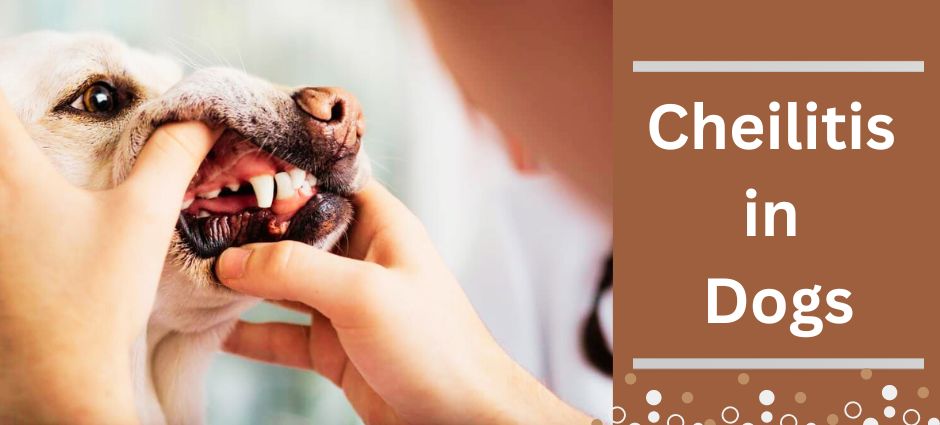Being parents to canines, we are dog lovers to the core of our hearts. Right! Well, you must be nodding. Therefore, we feel a lot, even on a minor dog sneezes.
Henceforth, one condition that can affect dogs yet is often overlooked is cheilitis. Cheilitis in dogs refers to the inflammation of the lips, a condition that can cause significant discomfort and lead to more serious health issues if not addressed.
Now, let’s get into the details!
What is Cheilitis in Dogs?
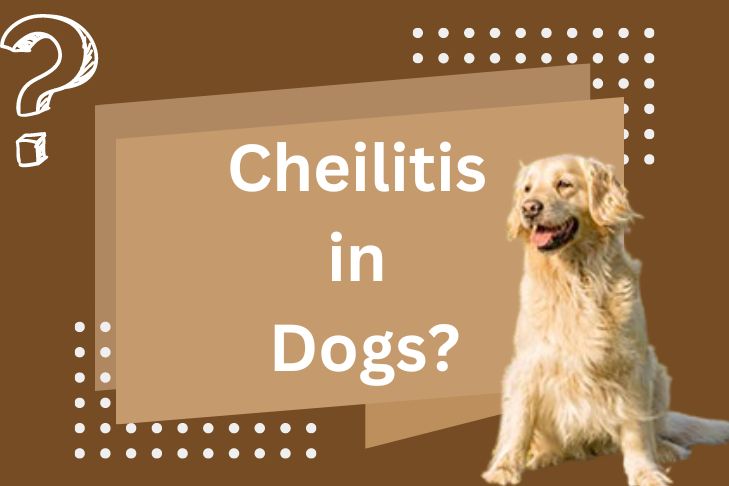
Cheilitis in dogs is the inflammation of the lips, which can manifest as redness, swelling, ulceration, or crusting of the lip area. It can affect one or both lips, along with the surrounding mucous membranes.
While it might seem like a minor issue, cheilitis can cause significant discomfort for different types of pups, like big fluffy dogs and, if left untreated, can lead to secondary infections or other complications.
What Causes Cheilitis in Dogs?
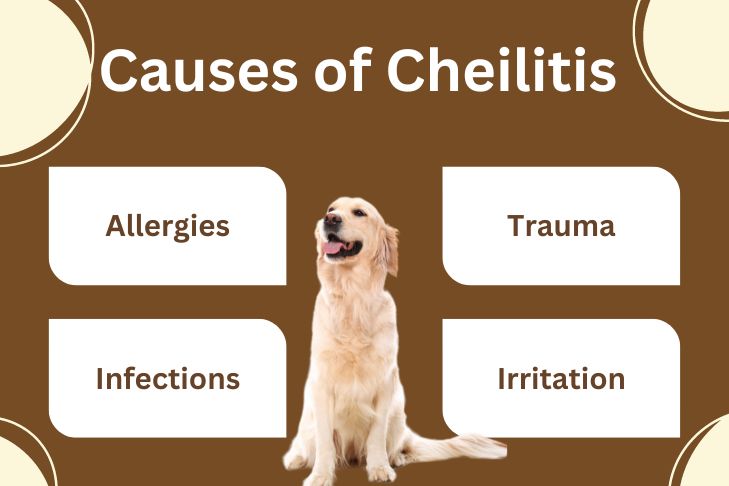
Some of the really common causes include:
Cheilitis in dogs is caused by a variety of factors, ranging from environmental influences to underlying health conditions.
1. Allergies
Allergic reactions are a common cause of cheilitis in dogs. Dogs can develop allergies to food, environmental allergens like pollen or dust mites, and contact allergens such as certain chemicals in grooming products. These allergies can lead to inflammation and irritation of the lips of your chunky dog.
Learn More: Check Our Articles balanoposthitis dog
2. Infections
Bacterial, fungal, or viral infections can cause cheilitis. Bacterial infections often occur secondary to trauma or irritation, while fungal infections like yeast can thrive in moist environments, leading to lip inflammation.
3. Trauma or Irritation
Physical trauma or irritation from chewing on objects, licking excessively, or exposure to harsh environmental conditions can result in cheilitis. Chronic lip licking or drooling can also cause the skin to become irritated and inflamed in your big breed gray dog.
4. Autoimmune Diseases
Autoimmune diseases, where the body’s immune system attacks its tissues, can manifest as cheilitis in dogs. Conditions like pemphigus or lupus can cause inflammation and ulceration of the lips.
5. Symptoms of Cheilitis in Dogs
Identifying dog cheilitis involves observing specific symptoms that indicate lip inflammation. These symptoms show differently in every dog, but commonly include:
- Redness and swelling of the lips
- Ulceration or sores on the lips
- Crusting or scabbing of the lip area
- Heavy Itching or excessive scratching of the lips
- Drooling or increased salivation
- Pain or discomfort when eating or drinking
If you notice any of these symptoms in your dog, it’s essential to seek veterinary attention promptly to determine the underlying cause and initiate appropriate treatment.
Diagnosing Cheilitis in Dogs
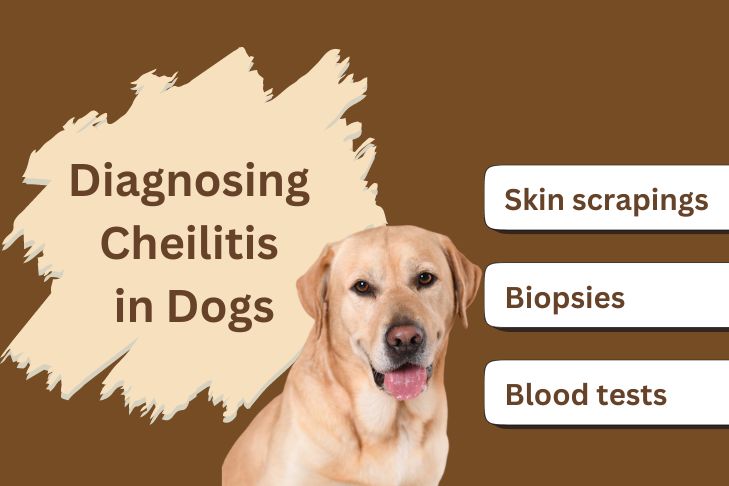
Diagnosing cheilitis involves a thorough examination by a veterinarian. The vet will take a detailed history of your dog’s symptoms, diet, and any recent changes in their environment. A physical examination of the lips and surrounding areas will be performed, and additional diagnostic tests may be recommended, such as:
- Skin scrapings or biopsies to identify infections or autoimmune conditions
- Allergy testing to determine potential allergens
- Blood tests to identify any hidden issues
Accurate diagnosis is crucial for developing an effective treatment plan tailored to your dog’s specific condition.
Treatment for Cheilitis in Dogs
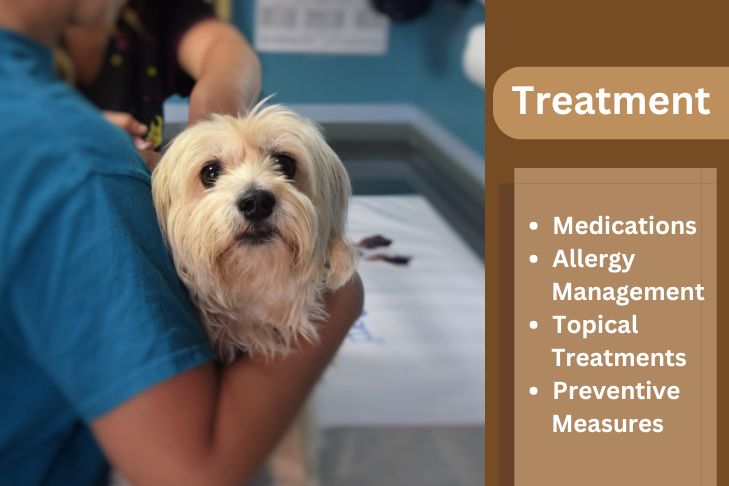
The treatment of cheilitis in furry little dogs depends on the underlying cause of the condition. Here are some common treatment options:
1. Medications
Depending on the cause, your veterinarian may prescribe medications to address infections or inflammation. It’s always best to use antibiotics to treat fungal and bacterial infections, such as dosages of aspirin, as they tend to stay longer otherwise and further affect the poor little furry dogs.
2. Allergy Management
If allergies are identified as the cause of cheilitis, managing the dog’s exposure to allergens is crucial. You should try switching up their food and grooming products, especially the ones around the mouth.
3. Topical Treatments
Topical treatments, such as medicated ointments or creams, can help soothe and heal inflamed lips. These treatments are often used in conjunction with other therapies to provide relief and promote healing.
4. Preventive Measures
Preventing cheilitis in dogs involves maintaining good overall health and hygiene. Regular grooming, a balanced diet, and avoiding known allergens can help reduce the risk of developing cheilitis. Additionally, monitoring your fluffy dog’s behavior and promptly addressing any signs of irritation or trauma can prevent the condition from worsening.
Conclusion
Cheilitis in dogs is a condition that requires attention and appropriate treatment to ensure your furry friend remains comfortable and healthy. By understanding the causes, recognizing the symptoms, and seeking veterinary care when needed, you can effectively manage cheilitis in dogs.
Always consult with your veterinarian for an accurate diagnosis and tailored treatment plans to keep your dog’s lips healthy and free from inflammation. Your vigilance and care can make a significant difference in your dog’s quality of life, ensuring they remain happy and healthy for years to come.



